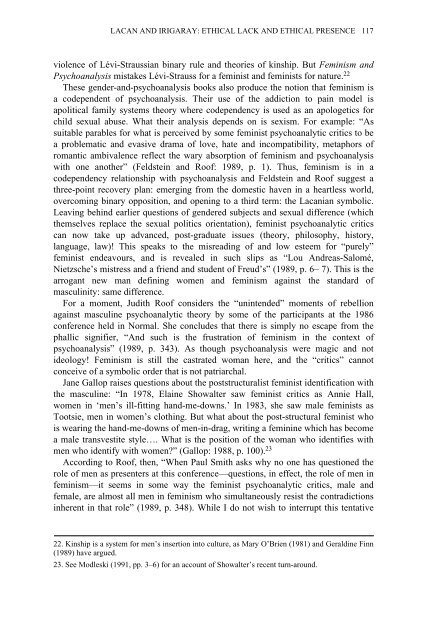Nothing Mat(t)ers: A Feminist Critique of Postmodernism
Nothing Mat(t)ers: A Feminist Critique of Postmodernism
Nothing Mat(t)ers: A Feminist Critique of Postmodernism
Create successful ePaper yourself
Turn your PDF publications into a flip-book with our unique Google optimized e-Paper software.
LACAN AND IRIGARAY: ETHICAL LACK AND ETHICAL PRESENCE 117<br />
violence <strong>of</strong> Lévi-Straussian binary rule and theories <strong>of</strong> kinship. But Feminism and<br />
Psychoanalysis mistakes Lévi-Strauss for a feminist and feminists for nature. 22<br />
These gender-and-psychoanalysis books also produce the notion that feminism is<br />
a codependent <strong>of</strong> psychoanalysis. Their use <strong>of</strong> the addiction to pain model is<br />
apolitical family systems theory where codependency is used as an apologetics for<br />
child sexual abuse. What their analysis depends on is sexism. For example: “As<br />
suitable parables for what is perceived by some feminist psychoanalytic critics to be<br />
a problematic and evasive drama <strong>of</strong> love, hate and incompatibility, metaphors <strong>of</strong><br />
romantic ambivalence reflect the wary absorption <strong>of</strong> feminism and psychoanalysis<br />
with one another” (Feldstein and Ro<strong>of</strong>: 1989, p. 1). Thus, feminism is in a<br />
codependency relationship with psychoanalysis and Feldstein and Ro<strong>of</strong> suggest a<br />
three-point recovery plan: emerging from the domestic haven in a heartless world,<br />
overcoming binary opposition, and opening to a third term: the Lacanian symbolic.<br />
Leaving behind earlier questions <strong>of</strong> gendered subjects and sexual difference (which<br />
themselves replace the sexual politics orientation), feminist psychoanalytic critics<br />
can now take up advanced, post-graduate issues (theory, philosophy, history,<br />
language, law)! This speaks to the misreading <strong>of</strong> and low esteem for “purely”<br />
feminist endeavours, and is revealed in such slips as “Lou Andreas-Salomé,<br />
Nietzsche’s mistress and a friend and student <strong>of</strong> Freud’s” (1989, p. 6– 7). This is the<br />
arrogant new man defining women and feminism against the standard <strong>of</strong><br />
masculinity: same difference.<br />
For a moment, Judith Ro<strong>of</strong> consid<strong>ers</strong> the “unintended” moments <strong>of</strong> rebellion<br />
against masculine psychoanalytic theory by some <strong>of</strong> the participants at the 1986<br />
conference held in Normal. She concludes that there is simply no escape from the<br />
phallic signifier, “And such is the frustration <strong>of</strong> feminism in the context <strong>of</strong><br />
psychoanalysis” (1989, p. 343). As though psychoanalysis were magic and not<br />
ideology! Feminism is still the castrated woman here, and the “critics” cannot<br />
conceive <strong>of</strong> a symbolic order that is not patriarchal.<br />
Jane Gallop raises questions about the poststructuralist feminist identification with<br />
the masculine: “In 1978, Elaine Showalter saw feminist critics as Annie Hall,<br />
women in ‘men’s ill-fitting hand-me-downs.’ In 1983, she saw male feminists as<br />
Tootsie, men in women’s clothing. But what about the post-structural feminist who<br />
is wearing the hand-me-downs <strong>of</strong> men-in-drag, writing a feminine which has become<br />
a male transvestite style…. What is the position <strong>of</strong> the woman who identifies with<br />
men who identify with women” (Gallop: 1988, p. 100). 23<br />
According to Ro<strong>of</strong>, then, “When Paul Smith asks why no one has questioned the<br />
role <strong>of</strong> men as present<strong>ers</strong> at this conference—questions, in effect, the role <strong>of</strong> men in<br />
feminism—it seems in some way the feminist psychoanalytic critics, male and<br />
female, are almost all men in feminism who simultaneously resist the contradictions<br />
inherent in that role” (1989, p. 348). While I do not wish to interrupt this tentative<br />
22. Kinship is a system for men’s insertion into culture, as Mary O’Brien (1981) and Geraldine Finn<br />
(1989) have argued.<br />
23. See Modleski (1991, pp. 3–6) for an account <strong>of</strong> Showalter’s recent turn-around.

















